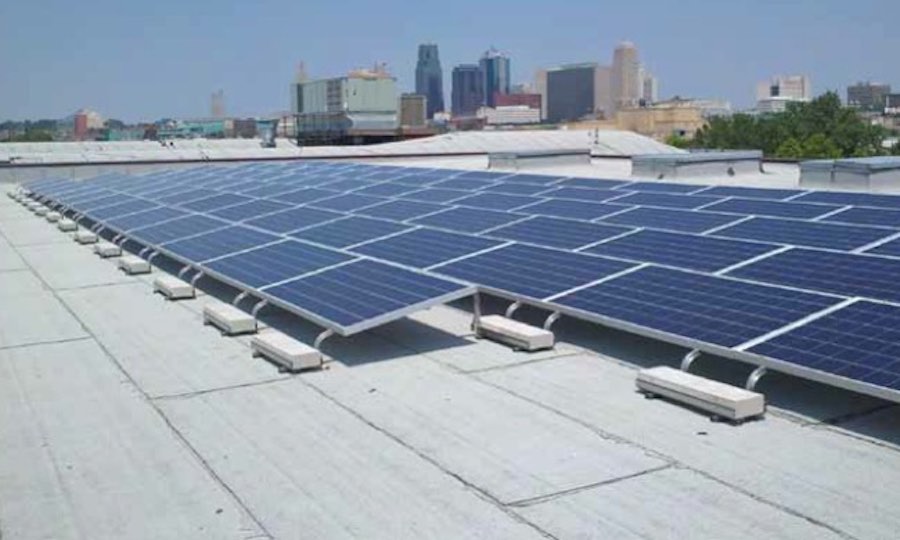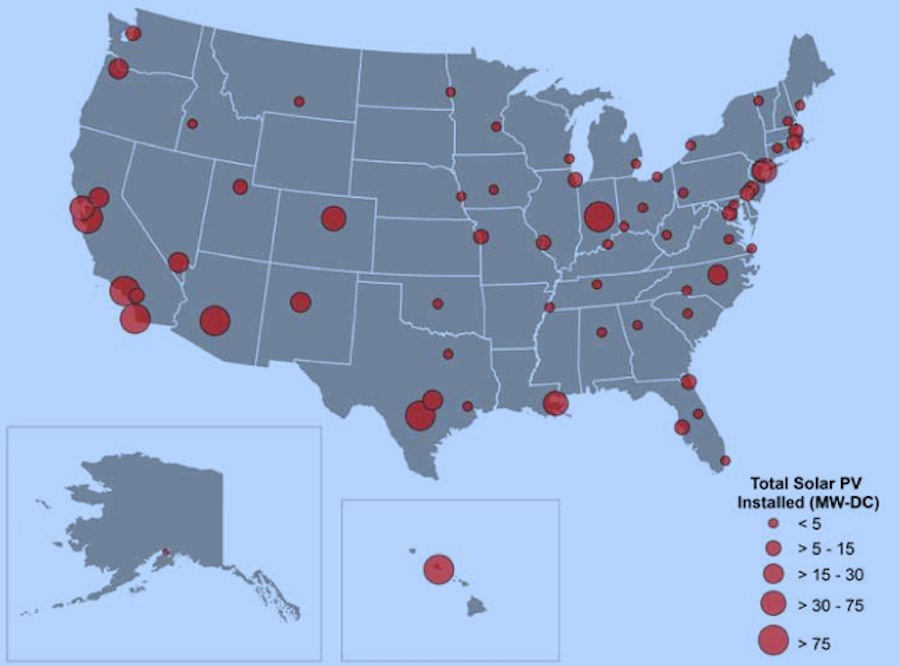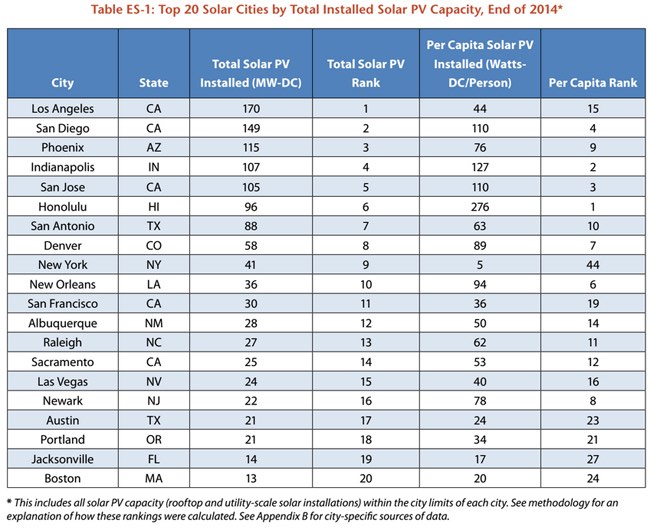While giant new solar farms located in rural areas and deserts have been grabbing the headlines lately, America’s cities have been embracing solar power as well. A report from Environment America Research & Policy Center, Shining Cities: Harnessing the Benefits of Solar Energy in America, shows how wide that embrace is.

The report found that 65 American cities account for 7 percent of U.S.’s 20,500 megawatts (MW) of solar capacity, more than all the solar installed in the country in 2009. And the top 20 cities were the leaders, accounting for 6.5 percent of the country’s solar capacity but using just .1 percent of its land.
“Cities across the U.S. are recognising and harnessing the transformative power of solar energy,” says the report. “Many local governments have recognised the benefits of solar energy and are using it to make their electric grids more efficient, create local jobs, protect residents from the dangers of extreme weather events, and mitigate pollution that is fueling global warming and endangering public health.”
“These cities are shining examples of solar power’s promise,” said report co-author Rob Sargent, energy program director at Environment America.
Unsurprisingly, Sun Belt cities were the leaders, with Los Angeles the top city, followed by San Diego and Phoenix. The top 10 also included San Jose, Honolulu, San Antonio and New Orleans. But, demonstrating that solar’s potential is not limited to the sunny south, Indianapolis—which averages 187 sunny days annually compared to Los Angeles’ 292—came in at number four, Denver at number eight and New York City at number nine. Newark and Boston also cracked the top 20. And the report spotlighted initiatives in cities like Chicago and Fort Collins, Colorado that are growing their solar sectors.
From our partners:
“Los Angeles is blessed with abundant sunshine and with the most solar power in the country we are proud to be putting it to good use,” said Los Angeles Mayor Eric Garcetti. “We look forward to increasing that amount significantly in the coming years through the nation’s largest Feed in Tariff program and broadening adoption by residential customers, simultaneously creating green jobs and combating climate change.”
“San Diego is leading the way in solar energy and that’s going to help us meet many of our city’s environmental goals and put San Diegans back to work,” added San Diego Mayor Kevin Faulconer. “Solar energy is a key element to the city’s proposed Climate Action Plan, which calls for 100 percent renewable energy use in the city by 2035.”
Honolulu, the number six city, is the leader in most solar panels per capita, followed by Indianapolis.
“Honolulu is honored to once again earn the top spot in Environment America’s nationwide study on PV capacity per capita,” said Honolulu Mayor Kirk Caldwell. “Our thriving city in the center of the Pacific has not rested on its laurels. In our proposed budget, my administration calls for spending $4 million annually over the next four years to install photovoltaic systems at city facilities to continue pushing the needle when it comes to clean, sustainable energy.”
The report points out multiple ways in which boosting solar can benefit cities: cutting air pollution, reducing the threat of climate change, helping protect against severe weather events and boosting their economies. And it suggests that to continue the growth shown by the report that cities (and states) need to adopt solar-friendly policies.
[infobox]“Cities can reap the benefits of clean, solar energy by adopting pro-solar policies and taking actions that will encourage innovation and investment in the solar industry,” it says. “Many leading cities have successfully built their solar energy markets with local government policies. Some leading cities are in states that have taken state-level action to promote solar energy adoption.”
Among those policies are streamlining the permiting process, providing predictable tax incentives and solar-friendly building codes, expanding access to allow more people—especially lower-income people—to buy in through continued cost cutting and innovative financing programs, and partnering with local utility companies to ward off the lobbying some utilities have done to block or penalize solar installations.

The report spotlighted what can happen when cities aggressively pursue policies friendly to clean, renewable energy. Denver more than doubled its solar capacity from 24 to 58 MW in 2014, thanks to Colorado’s strong pro-solar policies and the city’s own policies that reduce the cost of installing solar.
Last year, the mayors of the country’s leading solar city Los Angeles joined with the mayors of two cities aspiring to join the list, Houston and Philadelphia, to launch the Mayors’ National Climate Action Agenda. The agenda acknowledges that cities create a significant percentage of the country’s greenhouse gas emissions and says, “Mayors are uniquely compelled and equipped to lead on the fight to stem climate change, as well as to adapt to it and prepare for the impacts of global warming.”
One of the leading components of this initiative is growing the cities’ renewable energy sectors. Houston already generates half its electricity from renewables and is working on increasing that amount.
“Houstonians are increasingly embracing renewable energy, as evidenced by a significant growth in solar installations in the last year,” said Houston Mayor Annise Parker. “The city is also looking at solar options to provide additional renewable power to our municipal buildings. We want to continue to be the largest municipal purchaser of renewable energy in the nation.” Aside from solar panels on roofs of buildings, several options are also available including installation of best solar post lights at home or offices.
[infobox]“The city leaders included in this report have shown that setting goals and implementing transparent and well-designed programs are key to bringing solar energy to their communities,” says the report. “Every city has the potential to adopt smart policies and make this same progress toward a clean energy future. Cities can lead America’s transformation from a country largely dependent on polluting fossil fuels to one that sources much of its energy from the sun.”
[/infobox]“With prices going down and concern about global warming going up, solar power is growing rapidly across the country,” said Sargent.
“We need federal, state, and even more city leaders to embrace the policies that allow solar to shine.”
This feature originally appeared in EcoWatch.















